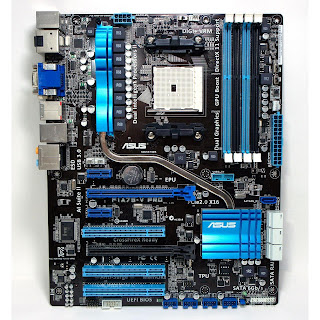The desktop Llano board in the lead at the moment
 |
| ASUS F1A75-V PRO |
We've seen just how good AMD's latest Fusion APU is in full desktop. Llano Lynx guise, but the chip itself is just half the story. Despite a hefty amount of the good stuf f now being jammed onto the chip itself - northbridge, CPU and GPU -there's still an awful lot left up to the motherboard. And to get the most out of the Llano APUs, you need a quality mobo partnership.
Asus has a pretty good name in Ihe motherboard market and this first Llano Lynx FMI-socket motherboard, the F1A75-V Pro. is only going to further that good feeling. It comes with all the lovelies we're expecting from this new A75 series of motherboards, namely up to 1,866MHz DDR3 support as well as what's hot in the world of interfaces - SATA 6Gb/s and USB 3.0. So hot right now... There will be cheaper, weaker A55 boards on their way, minus those two super-model I/O options, very soon.
One thing that impressed us was the amount of overclocking headroom. We've been playing around with Stars-based AMD CPUs for a good while and have rarely seen a chip take an almost 1GHz overclock before.
TheAsusFIA75-VProwas no bystander in this, beinga key component to getting that speed out of the chip itself. AMD supplied an MSI microATX FM1 board as part of the review kit and we could barely get a squeak out of it. The Asus 8I0S. though, gave us full access to the Llano APU's baseclock; as it stands that's the only way to boost this multiplier-locked chip.
That said, the APU multiplier setting in the BIOS was susceptible to the odd tweak, displaying huge frequency boosts in Windows but offering no actual performance increase in the real world. Still, the F1A75-V Pro gave us an A8-3850 running happily at 3.7GHz. Compared to the 2.9GHz stock speeds out of the box, that's a hefty kick in the clocks.
Going along with that base clock tweaking it also pushes up the DRAM frequency as well as the onboard graphics, and yet it remained stable across the board. Where the MSI board was initially reticent to allow us to up the memory frequency, the Asus board was only too happy to oblige, seeing the G.Skill RipJaws RAM at its native 1,600MHz speed straight away.
Dual graphics
Dual graphics didn't present a problem, either. All it took was a single tweak in the BIOS to enable multi-monitor support and the board happily enabled the CrossFire settings in the Catalyst suite on booting into Windows.
The only real snag with the board came on trying to plug in a discrete card alone, without running through the onboard graphics portion of the APU. After much installing and uninstalling we found our 05 was now ignoring all devices plugged into the various USB ports despite our best attempts.
But that's a fairly minor thing. With a board and chip at around £200, you can afford to drop a £75 Radeon HD 6670 in as a Dual Graphics array and come up with surprisingly playable frame rates.
While FMl-socket boards are still in their infancy, this Asus Fl A75-V Pro is currently setting the bar high, with solid overclocking support and a decent feature set.

Conversion Conversion Emoticon Emoticon